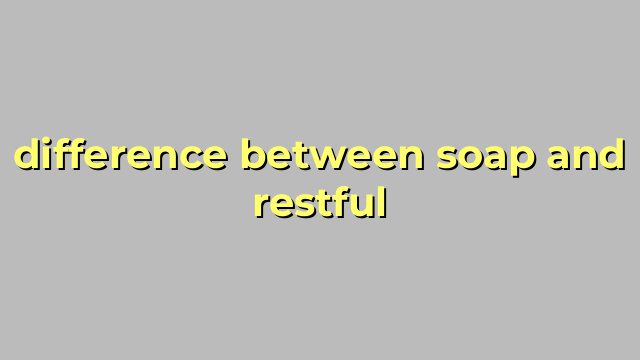The Difference Between SOAP and RESTful Web Services
When it comes to building web services, there are two popular technologies in use: SOAP and RESTful. While both of them are used for the same purpose of exchanging data between client and server, there are significant differences in their implementation and how they handle data.
What is SOAP?
SOAP (Simple Object Access Protocol) is a messaging protocol that uses XML for communication between systems. It uses the XML schema to define the data structure and WSDL (Web Services Description Language) to describe the messages passed between the client and server.
SOAP is a highly secure protocol that supports a wide range of communication protocols such as HTTP, SMTP, and JMS. It also has built-in error handling and reliable messaging capabilities that ensure the safe delivery of messages.
What is RESTful?
RESTful (Representational State Transfer) web services use HTTP methods to perform operations on data. It is a lightweight alternative to SOAP that uses simple data formats like JSON and XML to exchange data.
Unlike SOAP, RESTful does not require a separate messaging protocol or WSDL to describe the data. Instead, it relies on the HTTP methods like GET, POST, PUT, and DELETE to handle requests and responses. This makes it easy to implement and understand, even for developers who are new to web services.
The Differences Between SOAP and RESTful
The main differences between SOAP and RESTful web services are:
- SOAP is a protocol while RESTful is an architectural style.
- SOAP uses XML for message format while RESTful uses simpler formats like JSON and XML.
- SOAP requires a separate messaging protocol and WSDL for message description while RESTful relies on HTTP methods for communication.
- SOAP is highly secure and reliable with built-in error handling while RESTful has no built-in security measures.
Conclusion
Both SOAP and RESTful have their advantages and disadvantages, and choosing between them depends on the specific requirements of the project. SOAP is best suited for large, complex systems that require high levels of security and reliability, while RESTful is ideal for lightweight systems and APIs that need to be flexible and scalable. Ultimately, the choice between the two depends on what works best for your project.
Table difference between soap and restful
| Soap | Restful |
|---|---|
| SOAP stands for Simple Object Access Protocol. | REST stands for Representational State Transfer. |
| SOAP is a protocol. | REST is an architectural style. |
| SOAP uses XML for messaging. | REST use JSON or XML for messaging. |
| SOAP is more complex and heavy-weight. | REST is simpler and lighter-weight. |
| SOAP is more secure because it includes built-in security features. | REST relies on SSL/TLS for security. |
| SOAP is slower because of its heavier protocol. | REST is faster because of its lighter protocol. |
| SOAP messages are not cacheable. | REST messages are cacheable. |
| SOAP is more suitable for enterprise-level applications. | REST is more suitable for web-based applications. |
| SOAP is more standardized and has stricter rules. | REST is more flexible and has looser rules. |


